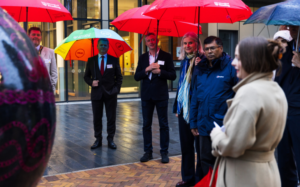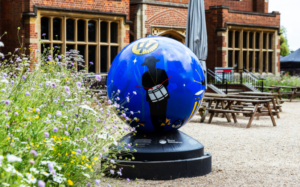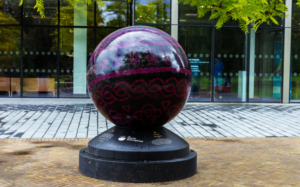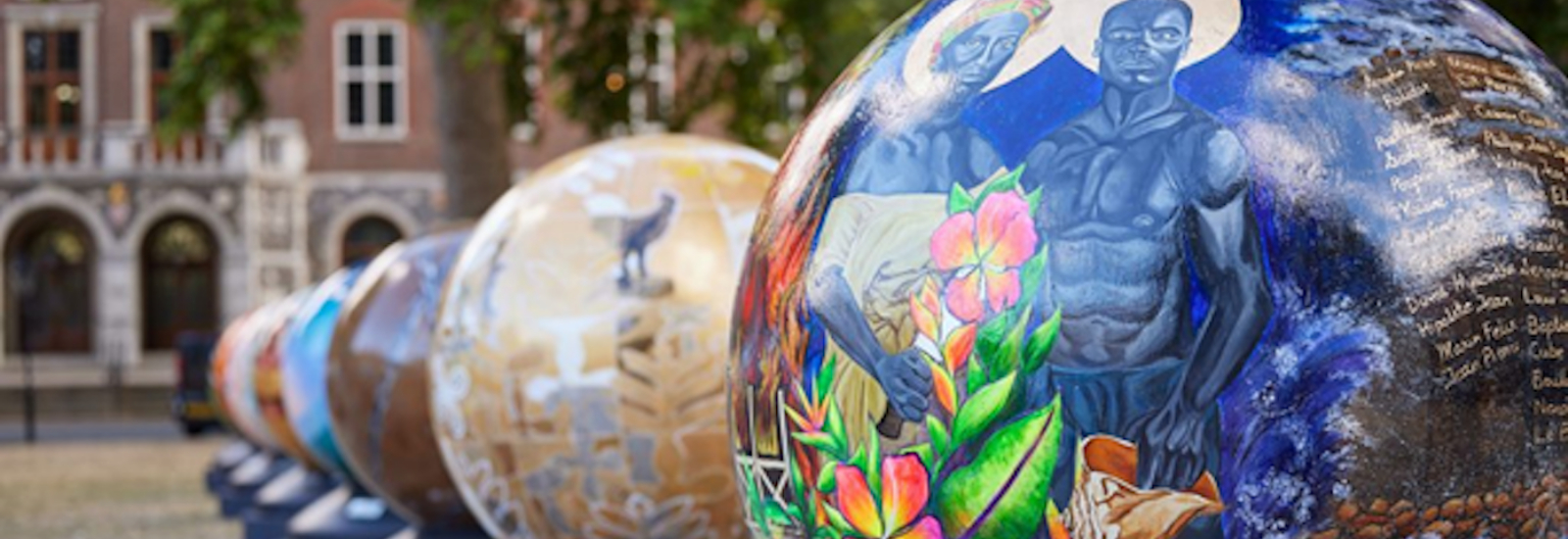The University of Reading welcomes a powerful new art installation to our grounds. The exhibition, made possible by our alumni community, explores the impact of the transatlantic slave trade.
 On Wednesday 25 September 2024 the University of Reading welcomed artists, donors and members of the local arts community onto campus to officially launch the new series of painted globes that reflect the legacy of the transatlantic slave trade.
On Wednesday 25 September 2024 the University of Reading welcomed artists, donors and members of the local arts community onto campus to officially launch the new series of painted globes that reflect the legacy of the transatlantic slave trade.
The installation of these globes has created a striking permanent public art exhibition across the University’s three UK campuses – Whiteknights and London Road in Reading, and at Greenlands in Henley-on-Thames. The globes, which form a thought-provoking art trail, were chosen by and made possible through donations by our alumni, students, staff and supporters of the University of Reading.
A journey of discovery
The globes were created for The World Reimagined initiative, an art-education project designed to transform how we understand the transatlantic trade in enslaved Africans and its ongoing impact. The project asks us to face our shared history and learn from it, to help create a future where everyone feels visible.
 Earlier this month, the creator of ‘Ancestral Connections’, Lou Boyce returned to campus to further enhance her globe. Ancestral Connections, which now proudly sits outside Park House, tells the story of Bajan tuk band music – a traditional form of music from Barbados which has its roots in West Africa. Lou said: “I’ve tried to use symbolism from both countries in the artwork.”
Earlier this month, the creator of ‘Ancestral Connections’, Lou Boyce returned to campus to further enhance her globe. Ancestral Connections, which now proudly sits outside Park House, tells the story of Bajan tuk band music – a traditional form of music from Barbados which has its roots in West Africa. Lou said: “I’ve tried to use symbolism from both countries in the artwork.”
The University’s art collection was formally brought together in 2015. With around 1,500 pieces ranging from sculptures, paintings, drawing and prints and spanning from the 16th century to the present day, it is quite the eclectic collection.
Dr Hannah Lyons, Curator of University Art Collections at the University of Reading, said: “We want to collect contemporary art that we can use to really engage our communities.
“The University is proud to host the work of four incredible contemporary artists, who each explore different themes that reflect the legacies of the transatlantic slave trade. From exploring the complexity of Britain’s relationship with Africa, the Americas and the Caribbean, to celebrating the spirit and culture of the African diaspora, each globe takes you on a journey of discovery.
“It is important to understand our past in order to create a more hopeful vision for the future.”
Watch the video below to hear more from Hannah and Lou – and to see Lou at work:
An educational catalyst
Head of Events and Co-Chair of the BAME (Black, Asian and Minority Ethnic) staff network at the University and Reading graduate, Aleiah Potter, played a leading role in the project.
 Aleiah said: “I hope this work serves as an educational catalyst, illustrating the untold, unheard, mistaught history of transatlantic slave trade. I hope it deepens knowledge, creates awareness, and helps everyone recognise the impact of racial injustices; both in the reflective explorations of devastating and enduring legacies, as well as in our present-day interactions and experiences.
Aleiah said: “I hope this work serves as an educational catalyst, illustrating the untold, unheard, mistaught history of transatlantic slave trade. I hope it deepens knowledge, creates awareness, and helps everyone recognise the impact of racial injustices; both in the reflective explorations of devastating and enduring legacies, as well as in our present-day interactions and experiences.
“As a shared centrepiece for our community and campuses, we establish a permanent learning opportunity and a physical reminder of our collective commitment to achieving racial justice for all.”
The globes were made possible through the support and donations from the University community. Aleiah explained: “A lot of alumni and supporters made a huge difference by donating towards acquiring the globes.
“We now have four which were chosen by our staff, students and alumni through a vote. It’s great that our entire community, who were such a big part of the globes’ journey to us, can now enjoy them.”
The globes trail is open to all so that University staff, students, alumni, supporters and the local community can visit, learn about and be inspired by the sculptures.
View the map trail now and discover the University of Reading’s programme of events to celebrate Black History Month.




